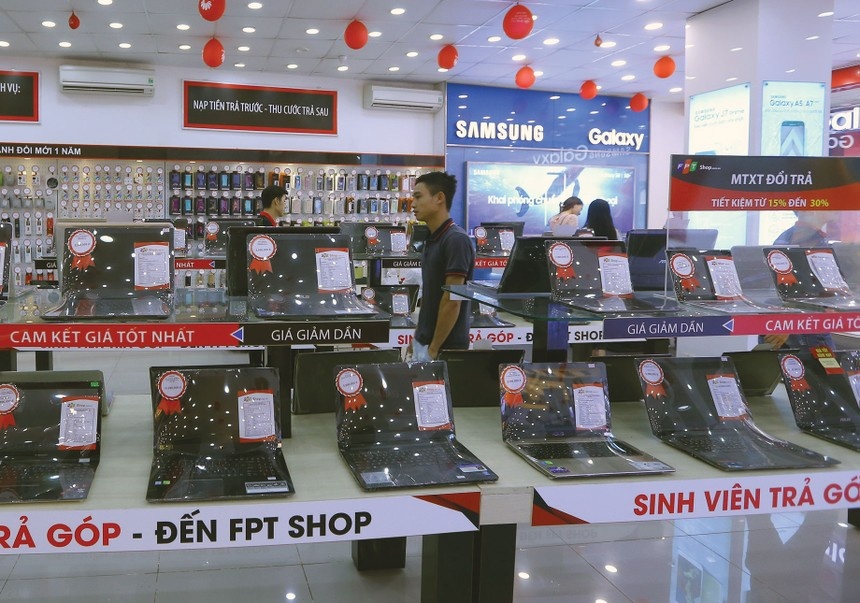Major electronics retailers face tough times
In the second quarter (Q2) of this year, MobileWorld JSC (MWG) saw 14 per cent drop on-year in its revenue falling to $1.24 billion, and a 98 per cent plunge in post-tax profit to $734,170.
In the first half (H1) of this year, MWG counted $2.38 billion in revenue and $1.62 million in post-tax profit.
The company has attributed that bleak situation to the weakening purchasing power for handsets and electrical products generally since Q4 of last year, and has yet to be resumed in H1 of this year, except for the demand for air-conditioners and fans due to seasonal weather.
 |
To draw new customers, MWG had come up with a large-scale sale promotion campaign from late March with attractive price discounts to boost sales. Consequently, the company’s total revenue surged 8 per cent in Q2 compared to Q1, yet the accrued profit margin in Q2 reduced.
Similarly, weak demand had also pulled down profit at Digiworld JSC. In Q2, the company posted $193.9 million in revenue and $3.5 million in post-tax profit, a 6 per cent and 39 per cent drop on-year, respectively.
The revenue in the handset segment slid 19 per cent on-year falling to $92.4 million during the period. This is also the segment with the largest contribution to the company’s revenue.
The office equipment segment had a 17 per cent drop in revenue falling to $30.8 million as businesses saved on costs.
In H1, Digiworld counted $361 million in revenue and $6.83 million in post-tax profit, down 28.2 per cent in revenue and 53.4 per cent in post-tax profit.
With such outcomes, the company has only completed 43 per cent of full-year revenue and 41 per cent of full-year post-tax profit projections.
The business picture at FPT Retail (FRT), belonging to tech giant FPT Corporation, is also gloomy. According to the company’s consolidated Q2 financial statement, FRT counted $302.5 million in revenue, up 15.5 per cent on-year, but incurred $9.05 million losses during the period compared to $1.97 million in profit one year ago.
FRT leaders have attributed Q2’s poor profit performance to consumer budget-tightening, particularly for high-value and not essential products.
In addition, competition among retailers is fierce, with many price discount battles.
In the first half of this year, FRT reported 6.6 per cent drop in revenue and incurred $8.9 million losses compared to $9.1 million profit one year ago.
Doan Hong Viet, Digiworld chairman, said that they expected better revenue in Q3 compared to Q2 and to regain growth momentum from Q4.
Both Digiworld and MWG pin their hopes on rebound prospects of the retail market in the rest of this year, leveraging the fact that Apple will be launching its flagship iPhone this October and better revenue from laptop sales ahead of srudents going back to school.
Viet assumes that a boom in growth will come in the second half of 2024, driven by a new product cycle and economic rebound, leading to burgeoning consumer demand.
Nguyen Bach Diep, chairwoman of FPT Retail is less optimistic, saying that difficult times will drag to the end of the year.
Diep said that in the long run FRT’s growth might see upbeat prospects, with the Long Chau drugstore chain set as an investment priority at present.
 | Apple retailers set for price competition shake-up The latest introduction of a standardised framework by Apple’s online store in Vietnam is likely to redefine the competitive landscape, creating a level playing field for retailers and raising the expectations of customers. |
 | Trends and opportunities for brands and retailers Vietnam is one of the five key markets in Asia-Pacific that hold growth potential for brands and retailers, with a strong preference for domestically produced goods. Helen Sac, consultant director for Asia-Pacific at consumer insights firm WGSN, talks to VIR’s Linh Le about emerging trends. |
 | South Korean retailers extend reach South Korean companies are showing significant interest in Vietnam’s flourishing retail sector, seeking to seize opportunities presented by the nation’s robust economic growth and sizable working-age population. |
 | Retailers weigh up the perks of e-voucher models Cooperation between e-voucher issuers and retailers is benefiting both sides and bringing more diverse shopping experiences to customers, but some companies require more proof of the effectiveness of digital vouchers. |
What the stars mean:
★ Poor ★ ★ Promising ★★★ Good ★★★★ Very good ★★★★★ Exceptional
Related Contents
Latest News
More News
- $250 million deal targets women-owned SMEs, sustainable agriculture (December 22, 2025 | 17:40)
- UOB sees Vietnam growth easing in fourth quarter (December 22, 2025 | 17:39)
- Government moves to establish International Financial Centre (December 21, 2025 | 21:00)
- Vietnam's IFC to target global investment flows (December 21, 2025 | 18:00)
- Ha Tinh breaks ground on major Vingroup industrial and energy projects (December 19, 2025 | 18:24)
- EVN launches major power infrastructure projects nationwide (December 19, 2025 | 18:17)
- VAL inaugurates second production line to meet domestic animal feed demand (December 19, 2025 | 16:37)
- Sun Group pioneers urban tram system in Phu Quoc (December 19, 2025 | 15:00)
- Top 10 notable events of Vietnam’s industry and trade sector in 2025 (December 19, 2025 | 14:00)
- Seven major projects launched to drive Hanoi’s next growth phase (December 19, 2025 | 14:00)

 Tag:
Tag:


























 Mobile Version
Mobile Version